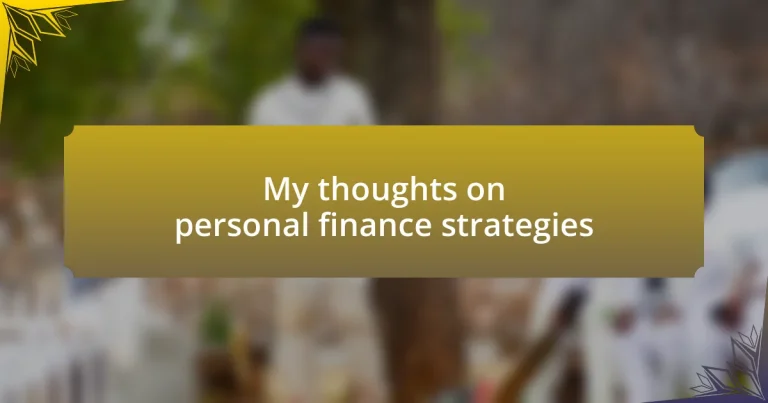Key takeaways:
- Understanding personal finance basics includes tracking expenses, budgeting, and distinguishing between needs and wants to improve financial control.
- Setting clear financial goals helps motivate better financial choices, with differentiation between short-term and long-term goals promoting a balanced approach.
- Implementing effective saving strategies like “pay yourself first” and automating savings can significantly enhance financial security.
- Smart investing principles focus on understanding risk tolerance, diversification, and prioritizing long-term outcomes over immediate gains.

Understanding Personal Finance Basics
Understanding personal finance basics is crucial for anyone looking to take control of their financial future. I remember when I first started tracking my expenses; it felt overwhelming but also liberating. Have you ever noticed how much small, daily purchases can add up? Once I began keeping a budget, I realized I could save more than I thought just by cutting back on those little indulgences.
One essential aspect of personal finance is distinguishing between needs and wants. I vividly recall a time when I splurged on the latest smartphone, only to later regret not saving that money for something more significant, like an emergency fund. This shift in perspective can be a game changer. Have you ever asked yourself what truly matters in your financial journey?
Investing can seem intimidating, but understanding the basics can empower you. When I first invested, it felt like a leap of faith, yet educating myself about stocks and mutual funds made all the difference. Imagine how much more confident you would feel making informed decisions about your investments! Taking control of your personal finance means becoming curious and proactive about your financial well-being.

Setting Clear Financial Goals
Setting clear financial goals is a foundational step in achieving financial success. When I first decided to map out my financial journey, I felt a wave of clarity wash over me. It’s surprising how defining exactly what you want—whether it’s a new home, a dream vacation, or simply a comfortable retirement—can motivate you to make better financial choices.
Differentiate between short-term and long-term goals to create a balanced approach. I remember setting a goal to save for a weekend getaway, which kept my savings journey exciting. In contrast, my long-term goal of retirement seemed daunting at first. However, once I broke it down into smaller milestones—like contributing to a retirement account monthly—it became manageable and less intimidating.
Visualizing your goals can also help reinforce your commitment. I created a vision board that included images related to my financial aspirations. Whenever I felt discouraged, I would glance at it and remember why I started. This practice energized my savings efforts and reminded me of the bigger picture. Have you ever visualized your financial goals in a similar way?
| Goal Type | Description |
|---|---|
| Short-term Goals | Goals to be achieved within a year, like saving for a vacation or paying off a small debt. |
| Long-term Goals | Goals that require time and planning, like saving for retirement or purchasing a home. |

Budgeting Techniques for Success
Budgeting Techniques for Success
When diving into budgeting, I’ve found that using the envelope system can be particularly effective. This technique involves allocating cash into envelopes designated for specific expenses such as groceries, entertainment, and bills. It may sound old-fashioned, but I remember how empowering it felt to physically see my spending limits. Watching those envelopes gradually empty helped reinforce my self-discipline and kept me focused on sticking to my plan.
Additionally, employing a 50/30/20 rule has provided me with a balanced budgeting approach. By dividing my income, I’ve learned to prioritize needs versus wants while still allowing for savings. This structure has allowed me some flexibility without losing sight of my financial responsibilities. Here’s a quick breakdown of this technique:
- 50% Needs: Essential expenses like housing, groceries, and utilities.
- 30% Wants: Non-essential expenses such as dining out, hobbies, and leisure activities.
- 20% Savings: Allocating funds towards savings, investments, or debt repayment.
Juggling these categories not only keeps my spending in check but also has brought me peace of mind, knowing I’m heading in the right direction financially.

Increasing Your Income Streams
When it comes to increasing income streams, I’ve always found that exploring side hustles can be both rewarding and enlightening. For instance, I started freelancing in my spare time, and it opened doors I didn’t even know existed. It’s amazing to think about how something I enjoyed could also boost my income—how many hobbies are you passionate about that could be monetized?
I also strongly believe in investing in myself through education. A couple of years ago, I took an online course that sharpened my skills in digital marketing. Honestly, it felt daunting at first, but the payoff was tremendous. Not only did it enhance my qualifications, but it also made me more confident in pursuing higher-paying job opportunities. Have you ever considered how upgrading your skills could change your financial landscape?
Lastly, real estate has been a significant game changer for me. After purchasing a rental property, I discovered the incredible potential of passive income. It wasn’t just about the monthly rent; it was about building equity and seeing my investment grow over time. Facing the challenges of being a landlord was initially intimidating, but witnessing those consistent cash flows reinvigorated my financial strategy. What if taking a calculated risk could significantly boost your income?

Effective Saving Strategies
Implementing effective saving strategies can transform your financial situation, and I can attest to that from personal experience. One technique that has been a game changer for me is the “pay yourself first” method. I set aside a fixed percentage of my income into a savings account before covering my bills or expenses. This approach not only creates a disciplined saving habit but also rewired my mindset about spending, prompting me to make more conscious financial choices. Have you ever thought about how prioritizing savings can shift your entire budgeting perspective?
I also make it a point to automate my savings. Just last year, I enrolled in a high-yield savings account that automatically transfers funds every payday. Initially, I was hesitant about not physically seeing the money in my checking account, but it turned out to be liberating. I didn’t miss the funds, and watching my savings grow without manual effort felt incredibly rewarding. Have you explored automation as a way to make saving painless?
Lastly, I can’t underscore the importance of setting specific savings goals. Knowing that I was saving for a vacation made it much easier to forgo some daily luxuries. It felt less like deprivation and more like a personal challenge. I remember the day I booked that trip—I reflected on how all those small sacrifices added up to an experience I’ll cherish forever. What would achieving financial milestones mean for your personal happiness and fulfillment?

Smart Investing Principles
Smart investing isn’t just about making decisions based on trends; it’s about understanding your risk tolerance and setting a clear financial goal. Early in my investing journey, I learned that asking myself what I was trying to achieve helped me choose the right investment vehicles. For instance, I once considered investing in high-risk stocks without assessing my comfort with volatility. That mistake taught me the importance of aligning my investments with my financial objectives.
Diversification has been another crucial principle for me. I always remember a time when I heavily invested in a single industry because I was captivated by its growth potential. When that sector faced a downturn, my portfolio dipped significantly. Since then, I’ve spread my investments across various asset classes. This not only cushions me against market fluctuations but also provides exposure to different growth opportunities. How balanced is your investment portfolio?
Moreover, I always prioritize long-term outcomes over short-term gains. I recall feeling tempted to sell during a market dip, driven by emotions rather than logic. Taking a step back and reminding myself of my long-term strategy prevented that rash decision. Investing is much like gardening; patience is vital as you nurture your investments to grow over time. Have you considered how a long-term perspective can safeguard your financial future?

Evaluating Financial Progress Regularly
Regularly evaluating financial progress is essential for staying on track toward my goals. When I revamped my budget last year, I found that reviewing my expenses and income monthly helped me identify areas where I was overspending. It felt like a light bulb moment when I realized that my coffee habit was costing me more than a small monthly bill; it was hindering my savings goals in a significant way.
I recall the first time I used a financial tracking app, which allowed me to visualize my spending patterns and investments. At first, I felt overwhelmed by the data, but soon it became a powerful tool for accountability. Addressing my budget variations became a rewarding challenge, and these adjustments not only improved my financial situation but also gave me confidence. Have you ever found a tool that transformed your understanding of your finances?
Each quarter, I reassess my investment portfolio, aligning it with my financial aspirations. The process can be emotional, as it often involves confronting losses or missed opportunities. However, asking myself if my current strategies serve my long-term vision allows me to make informed adjustments that keep me focused on growth. Isn’t it fascinating how regularly checking in can clarify our path forward?
